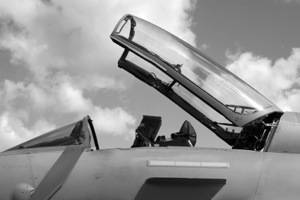The Mil-P-83310 Polycarbonate specification for sheet was written by the United States Air Force for the material that is used to construct the canopies on modern fighter jets.
Polycarbonate is used for these canopies due to its strength, clarity and resistance to damage from bird strikes.
The US Navy tends to use Stretched Acrylic for its canopies rather than polycarbonate. The main reason for the difference is assumed to be due to the different requirements for ejection from the aircraft. Ejections from Air Force jets tend to be at higher altitude and the canopy is discharged before the ejection seat is activated. For Navy aircraft there is a requirement to eject quicker due to the low altitude during carrier take off and landing operations. For this reason there is no time to eject the canopy first, so explosive charges detonate the canopy. Acrylic is able to shatter upon detonation, whereas the unbreakable nature of polycarbonate makes it unsuitable for this process.
[Note: Stretched Acrylic is significantly different to standard extruded or cast Acrylic PMMA sheet and there is a specification that covers this material for aerospace applications].Moving on to the Mil-P-83310 Polycarbonate specification, we will now detail why the material is different from standard polycarbonate sheet and why it is so difficult to produce to the specification.
The first and most obvious difference from standard polycarbonate sheet is the physical appearance of sheet. Most polycarbonate sheets have large amounts of blue dye to overcome the natural yellowness of the polycarbonate and any additional yellowness caused by adding regrind. The dyes do not remove the yellowness but rather mask it with a blue color. This makes the product appear brighter and cleaner. Even though the product appears brighter, the blue dyes actually lower the light transmission slightly, particularly in the blue part of the spectrum. This lowering of light transmission is not acceptable to the Air Force for canopies.
At HighLine we therefore use a special resin produced by one of our partners specifically for aerospace applications. These types of resins are only produced by a limited number of resin producers and are strictly controlled. We also use some proprietary technology to maximize the light transmission to meet the demands of the specification.
The next requirement of the specification is to control the internal strain or shrinkage of the material to less than 1%. Shrinkage has been discussed at length in another blog post by HighLine that can be found on this website. Most sheet manufacturers do not control shrinkage and those that do usually have a specification of 10%. Achieving the 1% target is a difficult proposition in sheet extrusion and requires advanced production techniques. Even though this target can be achieved by a well-run sheet extrusion operation using the latest sheet extrusion line, it can also be achieved post-production using advanced annealing techniques. These techniques will be discussed in a future blog post.
One of the most difficult parts of the specification to achieve is the control of minor defects such as bubbles, distortion and indents. The specification is significantly tighter than other optical grade polycarbonate applications such as transparent armor and ballistics glass for automobiles. Indeed some of the defects are difficult to detect with the naked eye and can only be observed with advanced viewing techniques (some of which are confidential to aerospace canopy manufacturers and their suppliers).
Other requirements of the specification that make it difficult to supply this grade of material include testing requirement, sampling, quality reporting and custom packaging. All of these technical and procedural requirements mean that it is very difficult to consistently produce and supply material against this specification. This difficulty is probably why only one or two suppliers other than HighLine Polycarbonate are able to produce material that meets the specification for this reasonably small, niche market.
If you are involved in the construction of military aircraft canopies and would like to discuss HighLine’s polycarbonate material meeting Mil-P=83310, please contact us by either email or phone.

